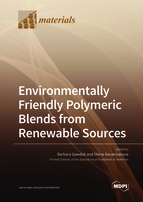Environmentally Friendly Polymeric Blends from Renewable Sources
A special issue of Materials (ISSN 1996-1944). This special issue belongs to the section "Advanced Composites".
Deadline for manuscript submissions: closed (31 May 2021) | Viewed by 36436
Special Issue Editors
Interests: synthesis of new monomers and polymers; chemical modification of synthetic and natural polymers; synthesis of porous polymers for applications in various chromatographic techniques; synthesis of novel polymer-based adsorbents having desired properties for health and environmental protection; synthesis and applications of imprinted polymers; synthesis and investigations of carbon adsorbents from synthetic and natural polymers; chromatographic analysis; investigations of porous structure of polymeric materials; use of recycled polymers in the synthesis; environmental protection, wasteless processes.
Special Issues, Collections and Topics in MDPI journals
Interests: carbohydrate chemistry; cellulosic materials; polymer chemistry; bio-based composites
Special Issues, Collections and Topics in MDPI journals
Special Issue Information
Dear Colleagues,
Materials from renewable resources have attracted increasing attention in the past decades as a result of environmental concerns and due to the depletion of petroleum resources. Polymeric materials from renewable sources have a long history. They were used in ancient times and later accompanied man along with the development of civilization. Currently, they are widespread in many areas of life and used, for example, in packaging and in the automotive and pharmaceutical industries.
Polymers from renewable resources are generally classified into three groups: i) Natural polymers, such as cellulose, starch, and proteins; ii) synthetic polymers from natural monomers, such as poly(lactic acid); and iii) polymers from microbial processes, such as poly(hydroxybutyrate). The emergence of new methods and analytical tools provides a new level of understanding of the structure–properties relationship of natural polymers and allows the development of materials for new applications.
One of the attractive properties of the natural polymers and synthetic polymers produced from natural monomers is their inherited biodegradability. However, this is related to their moisture sensitivity, which limits their application. Other important limitations of most polymers from renewable resources are their lower softening temperature and mechanical strength. These and many other properties of polymers can be modified and improved through the blending of two or more compounds, for example, two or more polymers, polymers and fibers, polymers and nanoparticles, etc.
A blending approach is an effective way to achieve a desirable combination of properties which are often absent in the individual components. The final properties can be modified by changing the relative concentration and kind of monomeric units used in the synthesis or by varying the proportion of homopolymers and various additives in a blend composition. Development of effective methods of manufacturing products from blends of renewable polymers and environmentally friendly synthetic polymers in a controlled way is the challenge of our time.
The aim of this Special Issue is to highlight progress in the manufacturing, characterization, and applications of environmentally friendly polymeric blends from renewable resources. It is our pleasure to invite you to submit your manuscript for it.
Prof. Barbara Gawdzik
Dr. Olena Sevastyanova
Guest Editors
Manuscript Submission Information
Manuscripts should be submitted online at www.mdpi.com by registering and logging in to this website. Once you are registered, click here to go to the submission form. Manuscripts can be submitted until the deadline. All submissions that pass pre-check are peer-reviewed. Accepted papers will be published continuously in the journal (as soon as accepted) and will be listed together on the special issue website. Research articles, review articles as well as short communications are invited. For planned papers, a title and short abstract (about 100 words) can be sent to the Editorial Office for announcement on this website.
Submitted manuscripts should not have been published previously, nor be under consideration for publication elsewhere (except conference proceedings papers). All manuscripts are thoroughly refereed through a single-blind peer-review process. A guide for authors and other relevant information for submission of manuscripts is available on the Instructions for Authors page. Materials is an international peer-reviewed open access semimonthly journal published by MDPI.
Please visit the Instructions for Authors page before submitting a manuscript. The Article Processing Charge (APC) for publication in this open access journal is 2600 CHF (Swiss Francs). Submitted papers should be well formatted and use good English. Authors may use MDPI's English editing service prior to publication or during author revisions.
Keywords
- Polymer blends
- Renewable resources
- Environmentally friendly polymers
- Biodegradability








